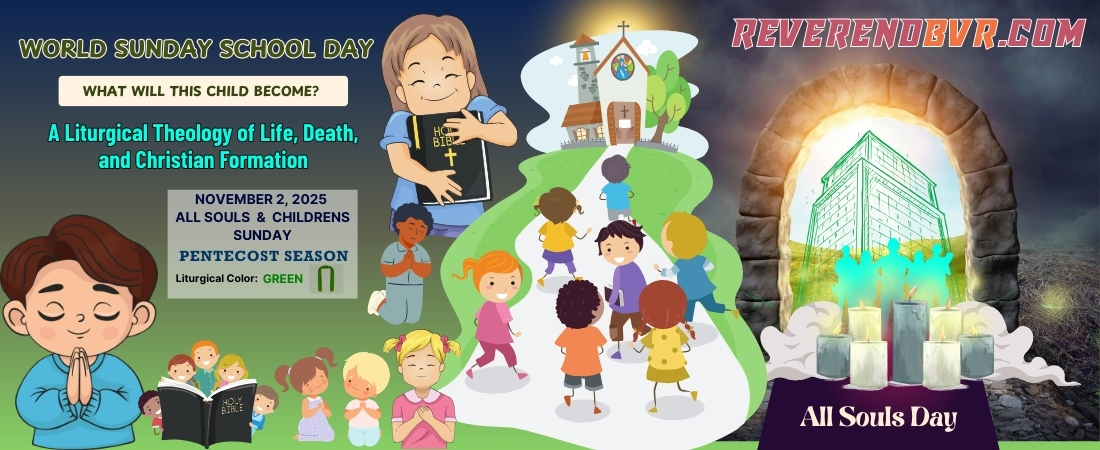On All Souls Day and Sunday School Sunday, we ask with sacred wonder, “What will this child become?”—not out of mere curiosity, but in deep trust that every life, from cradle to grave, is held within God’s eternal purposes, named by grace, and destined for glory. In the liturgy of life and death, Christian formation becomes the bridge between our mortal days and the divine vocation of becoming who God has called us to be.
Sermon Title: What Will This Child Become? A Liturgical Theology of Life, Death, and Christian Formation
Occasion: All Souls Day & Sunday School Sunday | October 2, 2025, Sunday.
Textual Foundations: Isaiah 25:6–9 | Psalm 24 | Revelation 21:1–6 | Luke 1:57–66
Original Language Reflections (For deeper study, refer to the Table of Hebrew and Greek Terms in Section 3 of the sermon).
By Reverend B.V.R. Memorial Ministry | www.reverendbvr.com
1.Introduction: The Liturgy of Life and Death
Today, we gather at the intersection of two powerful observances in the Christian calendar: All Souls Day, the day we remember those who have departed in the hope of the resurrection, and Sunday School Sunday, when we celebrate the formation of children in the knowledge and love of God. One day evokes memory and mourning; the other, joy and promise. But both point us to a singular hope: the sovereign Lord who gives life, calls each person by name, and gathers His people into eternal fellowship.
The question that animated the neighbors at the birth of John the Baptist—“What then will this child become?” (Luke 1:66)—also echoes through our commemoration today. What will become of the children we raise? What has become of those we lost? And what, ultimately, becomes of the human soul in the purposes of God?
I. The Hope of the Resurrection (Isaiah 25:6–9; Revelation 21:1–6)
Isaiah proclaims that the Lord of Hosts will “swallow up death forever” (Isaiah 25:8). The Hebrew verb billa’ (בִּלַּע) conveys a violent, permanent destruction. Death is not simply reversed; it is consumed. Revelation echoes this vision with apocalyptic grandeur: a new heaven and new earth, where “death shall be no more” and “mourning and crying and pain will be no more” (Rev. 21:4).
These are not abstract metaphysical claims but deeply personal promises. For every name we remember on All Souls Day, this is our confession: that they are not lost into oblivion, but gathered into a communion beyond time, held in the pierced hands of the risen Christ.
This eschatological hope shapes how we remember our departed. As Gregory of Nyssa argued, death is not the annihilation of the soul, but the threshold of its transformation. For Christians, to live is Christ, and to die is not loss, but gain (Philippians 1:21).
II. The Consecration of the Child (Luke 1:57–66)
When Elizabeth gave birth to John, the community asked, “What then will this child become?” (Luke 1:66). The Greek phrase, Ti ara to paidion touto estai?, suggests not mere curiosity but eschatological anticipation. The child’s birth was wrapped in divine promise; his future was seen as unfolding within the divine economy of salvation.
We ask the same of every child in our communities. Each carries a calling. John Chrysostom once said, “The soul of a child is soft and impressionable like wax; we must be careful what image we imprint upon it.”
On Sunday School Sunday, we affirm that Christian education is not merely moral formation, but theological participation. As Origen taught, children are to be nurtured as those bearing the imago Dei, destined to become partakers of the divine nature (2 Peter 1:4).
In John, we see how a child consecrated from the womb can become a prophet. But more than that, we see how every child’s life bears prophetic potential when formed in the presence of God.
III. The Continuum of Vocation: From Birth to Death
Theologically, childhood and death are not opposites, but bookends of a single vocation: life before God. The Psalmist proclaims, “The earth is the Lord’s and all that is in it” (Psalm 24:1), affirming God’s sovereign claim over every stage of life.
At birth, we ask, “What will this child become?” In death, we say, “They have become what God had called them to be.” The process in between is discipleship—a journey from baptism to beatitude.
As the early Church taught, Christian life is a pilgrimage toward theosis (divinization). This is not the privilege of mystics, but the vocation of every believer. All Souls Day, then, is not simply about death, but about the fulfillment of sanctification.
IV. Pedagogy of Eternal Things
In a world obsessed with ephemeral success, the Church must be a place that teaches children eternal significance. Sunday School is not childcare; it is soul-care. It is where we teach children to recognize their names in God’s story, not in the world’s fleeting acclaim.
Martin Luther, reflecting on children’s formation, said, “If I had to give up preaching and teaching and could do only one thing, I would choose to raise faithful children.”
Let our children ask of us: not only what grades they should earn, but what virtues they should embody; not only what careers they should pursue, but what cross they must bear.
V. Conclusion: Naming, Remembering, Hoping
At John’s birth, he was given a name not from family tradition, but from divine instruction: John (Yohanan), meaning “the Lord is gracious.” Our lives, too, are named by God, shaped by grace, and oriented toward glory.
On this day, we remember the names of the departed and the names of our children. Both are sacred. For in Christ, death is not the end, and childhood is not the beginning—both are moments in the eternal narrative of God’s redeeming love.
So we ask with reverence, What will this child become? Not only because we care for their future, but because we trust the One who holds it. Amen.
2. Closing Prayer:
Gracious God, On this sacred day, we remember those who have gone before us in the hope of the resurrection, and we celebrate the children growing in faith among us. Thank You for the promise that death is not the end, but the doorway to life with You.
Bless the children in our care—may they grow in wisdom, faith, and love. Help us to guide them with grace, imprinting Your image upon their hearts. And for those we remember today, we entrust them to Your eternal embrace, confident that they rest in Christ’s peace.
Hold us all in Your mercy—from birth to death and into everlasting life. In Jesus’ name, Amen.
3. Learn Words from the Original Scriptures (For deeper understanding and meditation on today’s theme)
| S.No | Word | Language | Transliteration | Meaning | Biblical Context | Explanatory Notes | |
| 1 | נַעַר (naʿar) | Hebrew | naʿar | Child, youth, servant | Used in Isaiah 7:16, 1 Samuel 1:24 | Refers broadly to a young person, ranging from toddler to adolescent. Also used of Samuel and other chosen youths. | |
| 2 | תַּלְמִיד (talmid) | Hebrew | talmid | Disciple, learner | Root of “Talmud” tradition | Not directly used in the Hebrew Bible, but foundational in rabbinic literature and Jewish pedagogy. | |
| 3 | παιδεία (paideia) | Greek | paideia | Discipline, education, training | Ephesians 6:4, Hebrews 12:5–11 | Involves holistic formation: moral, intellectual, and spiritual. Origin of the word pedagogy. | |
| 4 | σῶμα (sōma) | Greek | sōma | Body | 2 Corinthians 5:1–10, 1 Corinthians 6:19 | Refers to the human body physically, spiritually, and ecclesiologically (i.e., “Body of Christ”). | |
| 5 | οἶκος (oikos) | Greek | oikos | House, household, family | Luke 1:40, Acts 2:46, 1 Timothy 3:5 | Denotes not just a physical house, but a spiritual family and covenant community. | |
| 6 | παιδίον (paidion) | Greek | paidion | Little child | Matthew 18:2–5, Luke 2:27 | Diminutive of pais; refers to very young children. Used in Jesus’ teachings about humility. | |
| 7 | διδασκαλία (didaskalia) | Greek | didaskalia | Teaching, doctrine | 1 Timothy 4:13, Titus 1:9 | Refers to both the act and content of teaching; essential to faithful discipleship. | |
| 8 | ψυχή (psychē) | Greek | psychē | Soul, life | Luke 12:20, Mark 8:36, 2 Corinthians 5:1 | Describes the inner, animating life force. Often paired with sōma (body). |
4. Some Terms in the Sermon Explained for Better Understanding
| S.No | Term | Explanation |
| 1 | Formation | The lifelong spiritual, moral, and intellectual shaping of a person into the image of Christ. |
| 2 | Catechesis | Systematic religious instruction given to new or young believers, often before baptism/confirmation. |
| 3 | Ecclesia | Greek word meaning “assembly” or “church”; often used to denote the gathered people of God. |
| 4 | Eschatology | The branch of theology dealing with the “last things”: death, judgment, resurrection, and eternal life. |
5. Suggested Hymns:
- “For All the Saints”
- “I Was There to Hear Your Borning Cry”
- “Jesus Loves Me, This I Know”
6. Bibliography:
- Aquinas, Summa Theologica, Supplement Q71.
- Gregory of Nyssa. On the Soul and the Resurrection. Translated by C. M. F. Parson, 1967.
- Chrysostom, John. Homilies on the Gospel of Matthew. Translated by M. J. R. Eccles, 1979.
- Origen. On First Principles. Translated by G. W. Butterworth, 1957.
- The New Oxford Annotated Bible. Edited by Michael D. Coogan, 2018.
- Luther, Martin. Selected Sermons of Martin Luther. Edited by W. H. T. Dau, 1936.
- Tertullian. The Soul’s Testimony. Translated by R. S. H. Moorman, 1958.
- Willimon, William H. Worship as Pastoral Care. Abingdon Press, 1986.
- Wright, N. T. Surprised by Hope: Rethinking Heaven, the Resurrection, and the Mission of the Church. HarperOne, 2008.
- Zimmerman, David. A Theology of Christian Education. Baker Academic, 2003.
© 2025 ReverendBVR.com | High-Academic Sermon Series, 2025.
Content licensed under Creative Commons Attribution-NonCommercial-NoDerivatives 4.0 International (CC BY-NC-ND 4.0). You are free to share — copy and redistribute the material in any medium or format with proper attribution. No commercial use or modifications allowed without explicit permission.
For further sermons and biblical reflections, please visit 🌐 www.reverendbvr.com/sermons

